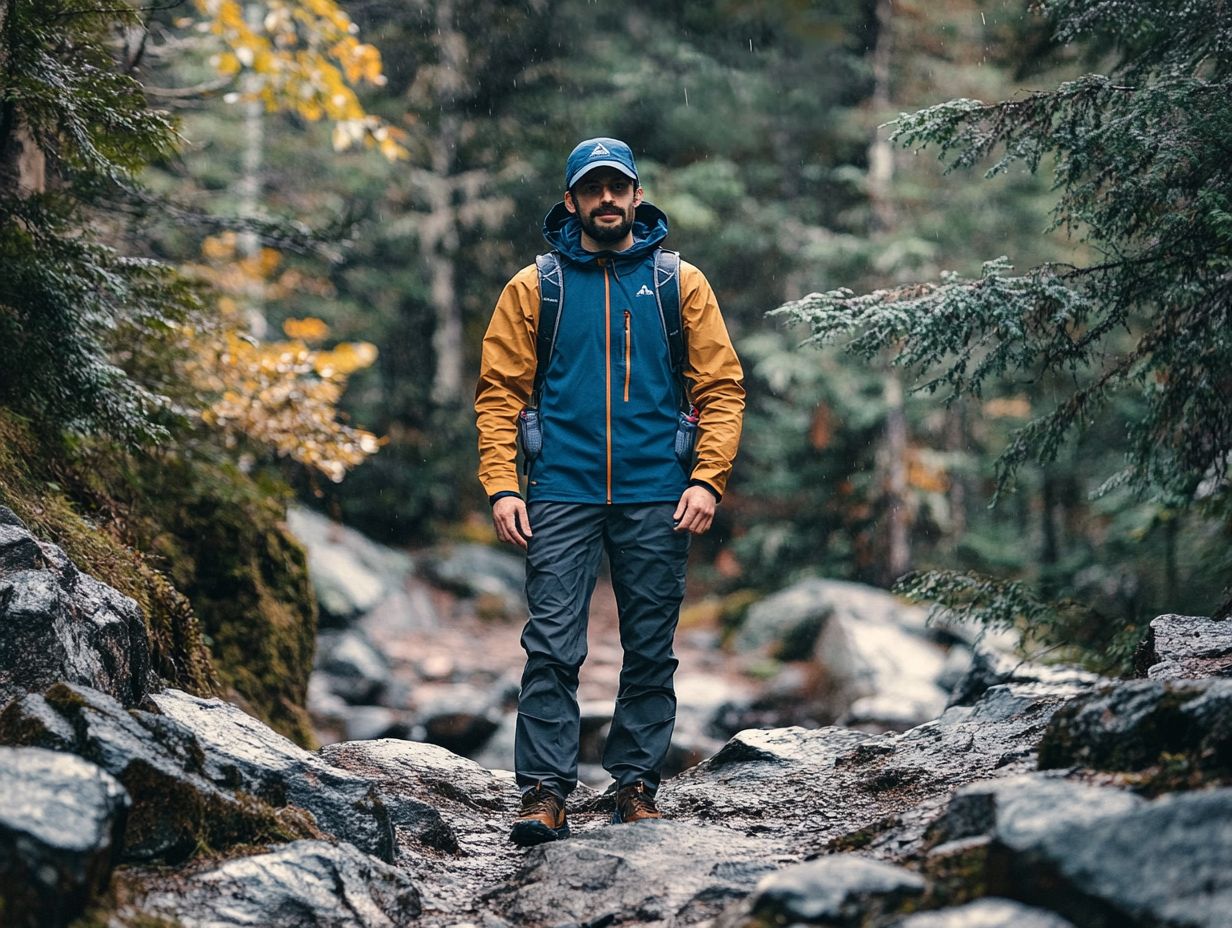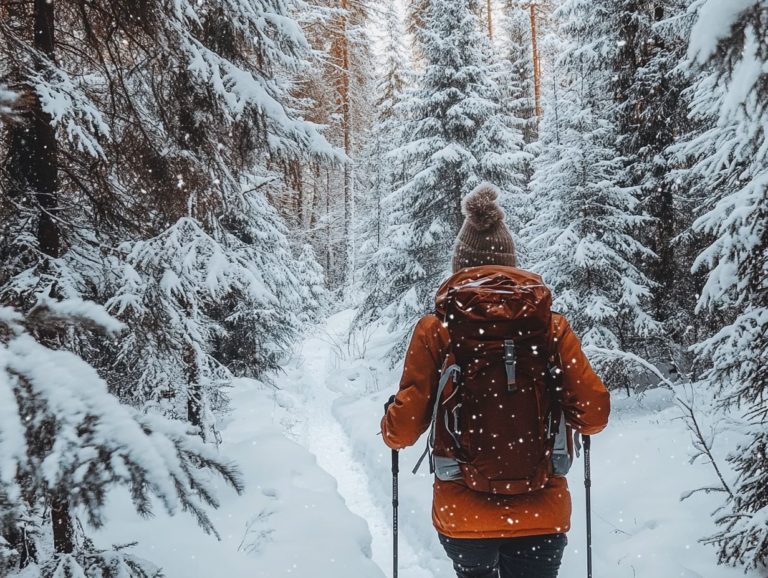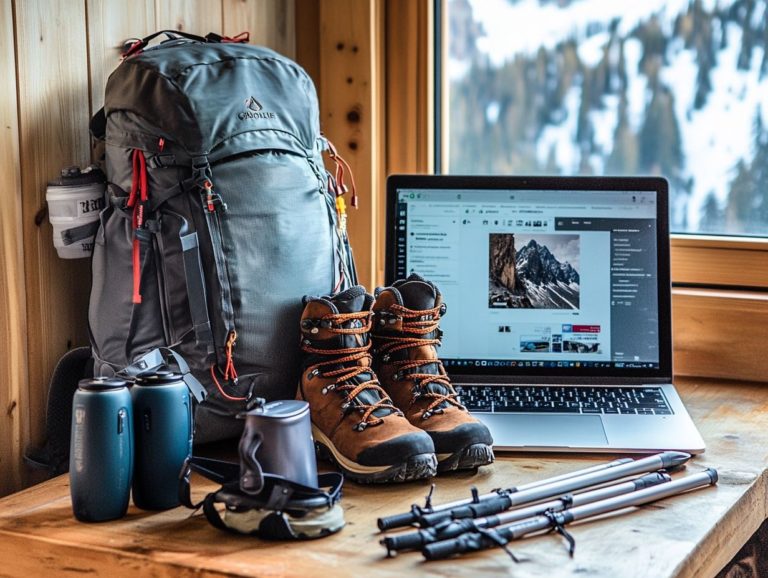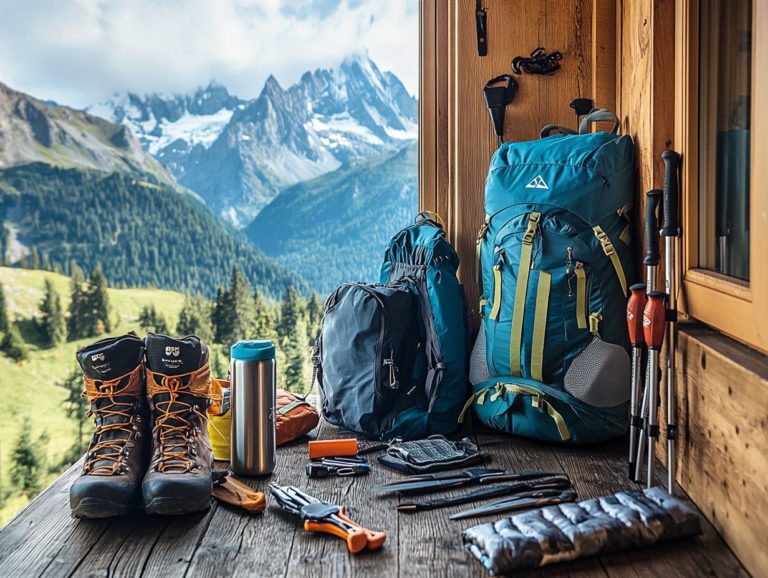How to Layer Clothes for Hiking
When you set out for a hike, the right clothing boosts your comfort and performance. Layering is key; it helps you adapt to changing weather and activity levels.
This guide will help you master effective layering for hiking. You ll learn how to choose the best base, mid, and outer layers, plus the right accessories.
This guide also offers tailored advice for various weather situations. Be prepared for anything Mother Nature throws your way!
Contents
Key Takeaways:
Understanding Layering for Hiking
The layering system is essential to elevate your comfort and safety outdoors. It consists of three parts: base layer, mid layer, and outer layer, each designed for specific roles in temperature regulation and moisture management.
By choosing the right hiking attire like synthetic fabrics and wool you can enhance your experience in the wilderness. It s about balancing heat retention and cold tolerance to ensure you re ready for whatever nature brings.
Why Layering is Important
Layering is crucial for hiking. It lets you adjust your clothing based on changing weather, optimizing comfort and temperature management.
This method is vital for preventing heat loss, especially during extended outdoor excursions. The insulation layer, made from materials like fleece or down, traps warmth while allowing moisture to escape, keeping you cozy without overheating.
By using strategic layering techniques, such as zip neck tops or lightweight jackets, you can respond swiftly to temperature changes whether it s a sudden evening chill or midday sun thus enhancing your overall experience on the trail.
Key Factors to Consider
When planning your layering system, consider your comfort level and the weather. Different conditions require different gear.
Your comfort is paramount, as everyone has different tolerances for temperature and moisture. It s also essential to evaluate the weather; hikes in rainy or windy climates demand more robust protection than those on mild, sunny days.
The right hiking gear varies with the seasons breathable fabrics are best for warmer weather, while insulated options are crucial for chilly hikes. A waterproof jacket can shield you from unexpected rain and wind.
Choosing the right layers affects breathability and plays a significant role in your enjoyment. Proper insulation and moisture-wicking properties can help you avoid overheating, making your hiking experience truly enjoyable.
The Base Layer
The base layer is the foundation of your hiking outfit. It manages moisture and helps keep you comfortable and warm.
Materials and Features to Look For

When selecting a base layer for your hiking gear, seek out base layer materials that excel in moisture-wicking properties and comfort. This means considering both natural fabrics like Merino wool and synthetic options.
Your ideal choice should prioritize breathability and fit. This ensures that the layer hugs your skin snugly without restricting your movement. Breathable materials help regulate your body temperature, allowing sweat to evaporate efficiently. For more tips on choosing the right gear, check out this guide on how to layer your outdoor clothing for maximum comfort. A proper fit also keeps chafing at bay during long treks.
As you weigh the options between natural and synthetic materials, think about their unique advantages. Natural fabrics often win points for being more environmentally friendly and providing natural odor resistance. In contrast, synthetic options generally excel in quick-drying capabilities and durability.
Understanding these factors can truly elevate your overall outdoor experience.
The Mid Layer
The mid layer is crucial in your hiking layering system. It is designed specifically to offer insulation that retains body heat and enhances your comfort in chilly conditions.
Insulating and Moisture-Wicking Qualities
When selecting a mid-layer for hiking, prioritize insulation properties and moisture-wicking qualities. This ensures a comfortable experience while effectively managing your cold tolerance.
Among the various materials that keep you warm, fleece and down truly shine for their heat retention capabilities. Fleece, with its lightweight nature and breathable texture, allows for excellent airflow while trapping warmth making it an ideal choice for your active endeavors.
On the flip side, down insulation offers superior thermal efficiency. However, consider how it performs in wet conditions. This is where moisture-wicking properties in your mid-layer become essential. This feature helps draw sweat away from your skin, preventing heat loss and keeping your body temperature comfortable.
This is especially important during strenuous outdoor activities where both performance and warmth are key.
The Outer Layer
The outer layer acts as your primary shield against the elements. It is expertly crafted to guard against wind, rain, and snow. It ensures that you remain both breathable and comfortable throughout your hiking escapades.
Choosing the Right Shell
Selecting the right shell for your outer layer is essential for protecting yourself against unpredictable weather conditions. Consider materials like Gore-Tex and brands such as Patagonia for the best performance.
When you think about an outer layer, several key factors can greatly influence your outdoor experience. Waterproofing is crucial to keep you dry in rainy climates. Breathability allows moisture from perspiration to escape, ensuring your comfort during physical activities. For a comprehensive understanding of what to wear for a multi-day hiking trip, durability is equally important; your gear must withstand the challenges of harsh environments.
Leading brands in the industry utilize advanced technologies like Gore-Tex fabrics. These not only enhance waterproof capabilities but also offer superior ventilation. This powerful combination is vital for improving the performance of your outdoor gear. It ensures you re always ready for whatever nature throws your way.
Accessories for Layering

Accessories are crucial for elevating your layering system while hiking. They ensure that you re fully equipped to handle various weather conditions. This allows you to maximize comfort during your outdoor adventures.
Hats, Gloves, and Socks
Choosing the right hats, gloves, and socks is essential for comfort on your hiking adventures. These accessories help manage moisture and prevent heat loss.
A well-fitted hat does more than shield your eyes from the glaring sunlight; it also helps regulate heat, keeping you from overheating on those warm trails. Gloves made from weather-resistant materials give you the dexterity you need while keeping your hands toasty and ready to tackle any challenge.
When it comes to socks, selecting moisture-wicking fabrics can prevent blisters and enhance your overall comfort during long treks. Each accessory is a vital piece of your layering system, providing the adaptability and efficiency you need to tackle changing weather conditions. For more details, check out this guide for winter hikes so you can focus on enjoying the journey ahead.
Tips for Layering in Different Weather Conditions
Layering in various weather conditions is crucial for maintaining both comfort and safety during your hiking adventures. It requires tailored strategies for hot weather, cold weather, and rain, allowing you to adapt seamlessly to whatever nature throws your way.
Hot Weather, Cold Weather, and Rain
Understanding how to modify your attire enables you to fully enjoy your time outdoors without the discomfort that can stem from unsuitable clothing choices. In hot weather, prioritize lightweight and breathable fabrics, such as moisture-wicking polyester or linen, to keep sweat at bay and promote airflow.
When temperatures drop, it’s vital to layer up with warm materials like merino wool or fleece, which trap heat while managing moisture. For more tips on staying cozy outdoors, check out this guide on how to stay warm while hiking. In rainy conditions, turn to water-resistant outer layers—think breathable rain jackets or durable shells—to keep yourself dry while providing insulation where necessary.
By strategically choosing and adjusting each layer according to these environmental factors, you can ensure that you remain comfortable and safe, no matter what Mother Nature throws your way.
Frequently Asked Questions
Got questions about hiking attire? We’ve got answers!
How to Layer Clothes for Hiking?

Layering clothes for hiking is important because it helps regulate your body temperature and keeps you comfortable throughout your hike. Here are some tips on how to layer clothes for hiking:
- Start with a moisture-wicking base layer.
- Add an insulating mid layer for warmth.
- Finish with a protective outer layer against the elements.
What is the Base Layer for Hiking?
The base layer is the first layer of clothing that sits directly on your skin. It is designed to wick moisture away from your body and keep you dry. Look for base layers made of moisture-wicking materials like merino wool or synthetic fabrics.
Why is a Mid Layer Important for Hiking?
The mid layer is the second layer of clothing and provides insulation to keep you warm. This layer should be made of a lightweight, breathable material that can easily be removed if you get too hot.
What is the Best Material for a Mid Layer?
For a mid layer, look for materials that are lightweight and breathable, such as fleece or down. These materials are great for trapping heat while still allowing moisture to escape.
How Many Layers Should I Wear for Hiking?
The number of layers you wear will depend on the weather conditions and your personal preference. Generally, it’s recommended to have at least three layers: a base layer, a mid layer, and an outer layer.
What Should I Wear for the Outer Layer?
The outer layer, also known as the shell layer, is designed to protect you from the elements. Look for a waterproof and windproof jacket or pants made of breathable materials. This layer should also fit comfortably over your other layers.






